*NURSING > QUESTIONS & ANSWERS > ENPC Test Questions and Answers Latest 2022 Graded A+ (All)
ENPC Test Questions and Answers Latest 2022 Graded A+
Document Content and Description Below
ENPC Test Questions and Answers Latest 2022 Graded A+ An unresponsive 2-year-old child was found by his mother with a bottle labeled "Elavil 50 mg" by his side. Which piece of information is import... ant to obtain from his mother? A. The size of the medication bottle. B. The expiration date of the medication. C. The number of pills left in the bottle. D. The person for whom the medication was prescribe. ✔✔C. The number of pills left in the bottle. A nurse providing crisis intervention to the family of a seriously ill child can best keep the family informed of the child's condition by: A. Placing them in a secluded room. B. Referring to their child as "the patient". C. Telling the family how they should feel. D. Appointing one staff member to communicate with them. ✔✔D. Appointing one staff member to communicate with them. A 16-month-old child was an unrestrained front seat passenger in a motor vehicle crash. The chest x-ray reveals multiple rib fractures. These findings suggest what type of injury? A. Minor surface injury. B. Significant underlying injury. C. Significant surface injury. D. Minor underlying injury. ✔✔B. Significant underlying injury. Which piece of information is most important to know prior to transferring a patient to another facility? A. Documentation of the family's health insurance coverage. B. Pertinent family health history. C. Confirmation of acceptance from the receiving hospital. D. Confirmation of a medical diagnosis. ✔✔C. Confirmation of acceptance from the receiving hospital. A 10-year-old child who was struck by a car has a distended, tense abdomen. The child's heart rate is 144 beats/minute, respirations 24 breaths/minute, and blood pressure 120/80 mm Hg. Capillary refill is more than 3 seconds, and skin is pale and cool. The patient's signs and symptoms suggest: A. Obstructive shock. B. Distributive shock. C. Hypovolemic shock. D. Cardiogenic shock. ✔✔C. Hypovolemic shock. A school-aged child is about to receive stitches. To evaluate his understanding of the procedure, you tell him: A. "Young people your age have questions about getting stitches. What are your questions?" B. "Don't cry while you are getting the stitches. Be brave like a man." C. "You will probably receive 10 stitches. Do you have any questions before we restrain you?" D. "Does your cut hurt? Would you like your mommy to hold you?" ✔✔A. "Young people your age have questions about getting stitches. What are your questions?" What is the preferred sit for intraosseous access in the infant? A. Lateral malleolus B. Iliac crest C. Proximal femur D. Anteromedial tibia ✔✔D. Anteromedial tibia An important consideration in the assessment of pain for an adolescent patient is that they: A. May deny or minimize their pain when friends visit for fear of losing control. B. Have difficulty localizing or describing the pain. C. Are unable to use the 1 to 10 scale to report their pain. D. Feel that the pain is a punishment for something they did wrong. ✔✔A. May deny or minimize their pain when friends visit for fear of losing control. An 8-month-old infant with pneumonia has severe intercostal and substernal retractions, weak muscle tone, lethargy, and gray skin color. The infant's condition does not improve after bagmask ventilation. The next step in treatment is most likely to be: A. Administration of epinephrine. B. Supplemental warming measures. C. Rapid sequence intubation. D. Administration of albuterol. ✔✔C. Rapid sequence intubation. Which combination of medications is best to have prepared for a pediatric resuscitation? A. Dopamine and sodium bicarbonate. B. Epinephrine and glucose. C. Naloxone and lidocaine. D. Pentothal and vecuronium. ✔✔B. Epinephrine and glucose. A 20-day-old infant has a 1-week history of not eating well. The infant has a weak cry and is jittery. Which laboratory test is indicated? A. Arterial blood gas. B. Finger-stick glucose. C. Complete blood count with differential. D. Toxicology screen. ✔✔B. Finger-stick glucose. Which intervention should be performed next if tactile stimulation, positioning, drying, and blow-by oxygen administration do not increase a newborn's heart rate? A. Chest compressions. B. Umbilical vein cannulation. C. Endotracheal intubation. D. Bag-mask ventilation. ✔✔D. Bag-mask ventilation. A 10-kg child has deep partial-thickness burns over 35% of the total body surface area. Which evaluation parameter indicates that fluid resuscitation is adequate? A. Heart rate of 160 beats/minute. B. Respiratory rate of 34 breaths/minute. C. Blood pressure of 80/60 mm Hg. D. Urine output of 11 ml/hour. ✔✔D. Urine output of 11 ml/hour. A 7-year-old female sustains a minor head injury and did not lose consciousness. She does not respond to commands and groans in response to questions. Which action will quickly determine if her behavior indicates a serious head injury? A. Review her medical record for pre-existing developmental problems. B. Obtain a head computerized tomography scan. C. Conduct a developmental screening test. D. Ask the parents if her behavior is unusual. ✔✔D. Ask the parents if her behavior is unusual. An 8-month-old child presents with purpura, irritability, and a rectal temperature of 39.4�C (102.9�F). An intervention of high priority is: A. Encouraging the caregiver to hold and comfort the child. B. Monitoring for signs and symptoms of increased intracranial pressure (ICP). C. Collecting urine for toxicology screen. D. Encouraging oral fluids and food. ✔✔B. Monitoring for signs and symptoms of increased intracranial pressure (ICP). The Pediatric Assessment Triangle is used to: A. Identify all life-threatening conditions that the child presents with. B. Perform a complete head-to-toe assessment on the child. C. Assess the status of the child's airway only upon arrive in the ED. D. Determine the severity of the child's illness or injury using the "across-the-room" assessment. ✔✔D. Determine the severity of the child's illness or injury using the "across-the-room" assessment. The caregivers of a 6-year-old boy who is brought to the emergency department for abdominal pain should first be asked: A. "Are his immunizations current?" B. "Has anything happened to him at school recent [Show More]
Last updated: 1 year ago
Preview 1 out of 7 pages
.png)
Reviews( 1 )

by colleen · 1 year ago
Document information
Connected school, study & course
About the document
Uploaded On
Aug 11, 2022
Number of pages
7
Written in
Additional information
This document has been written for:
Uploaded
Aug 11, 2022
Downloads
2
Views
264
.png)

.png)
.png)
.png)
.png)
.png)
.png)


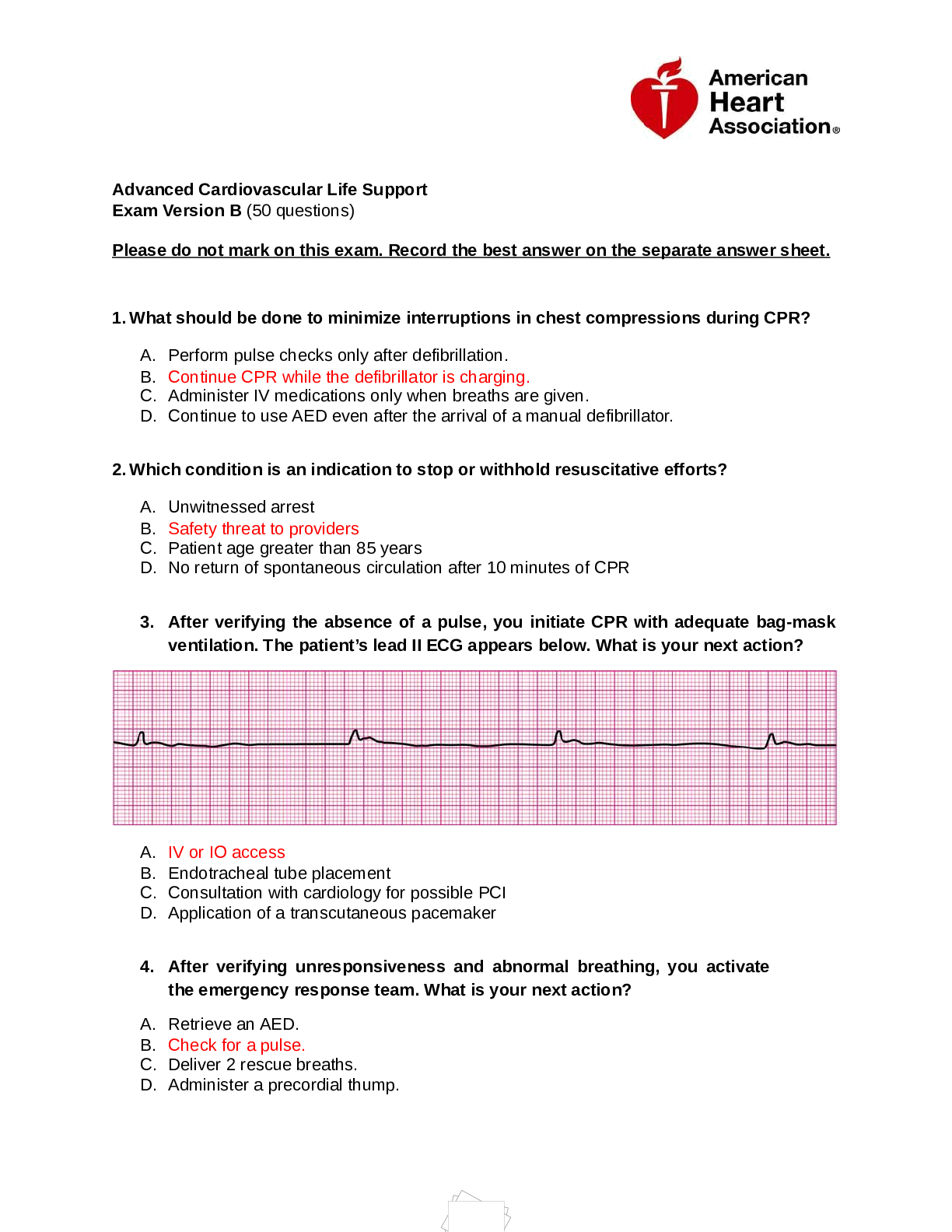


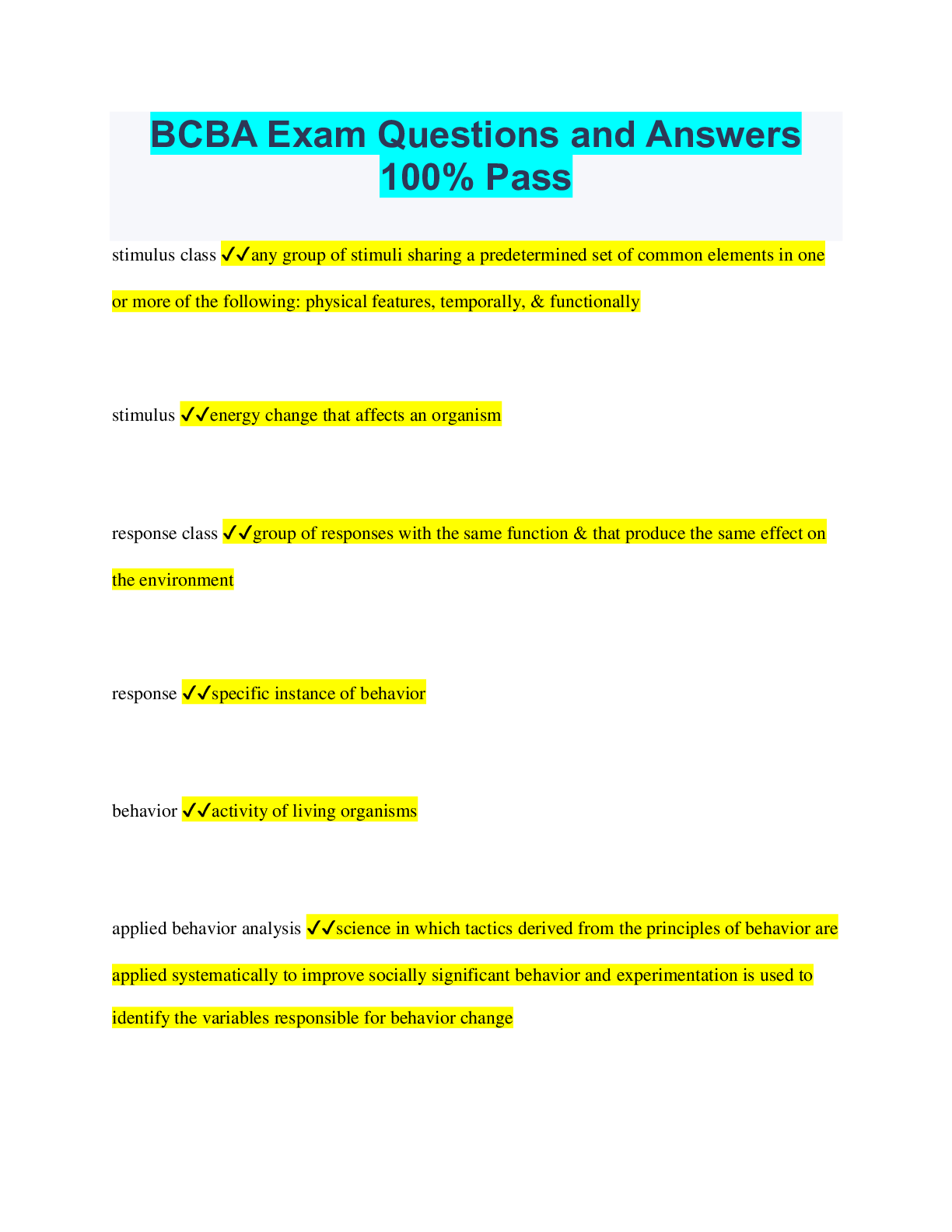
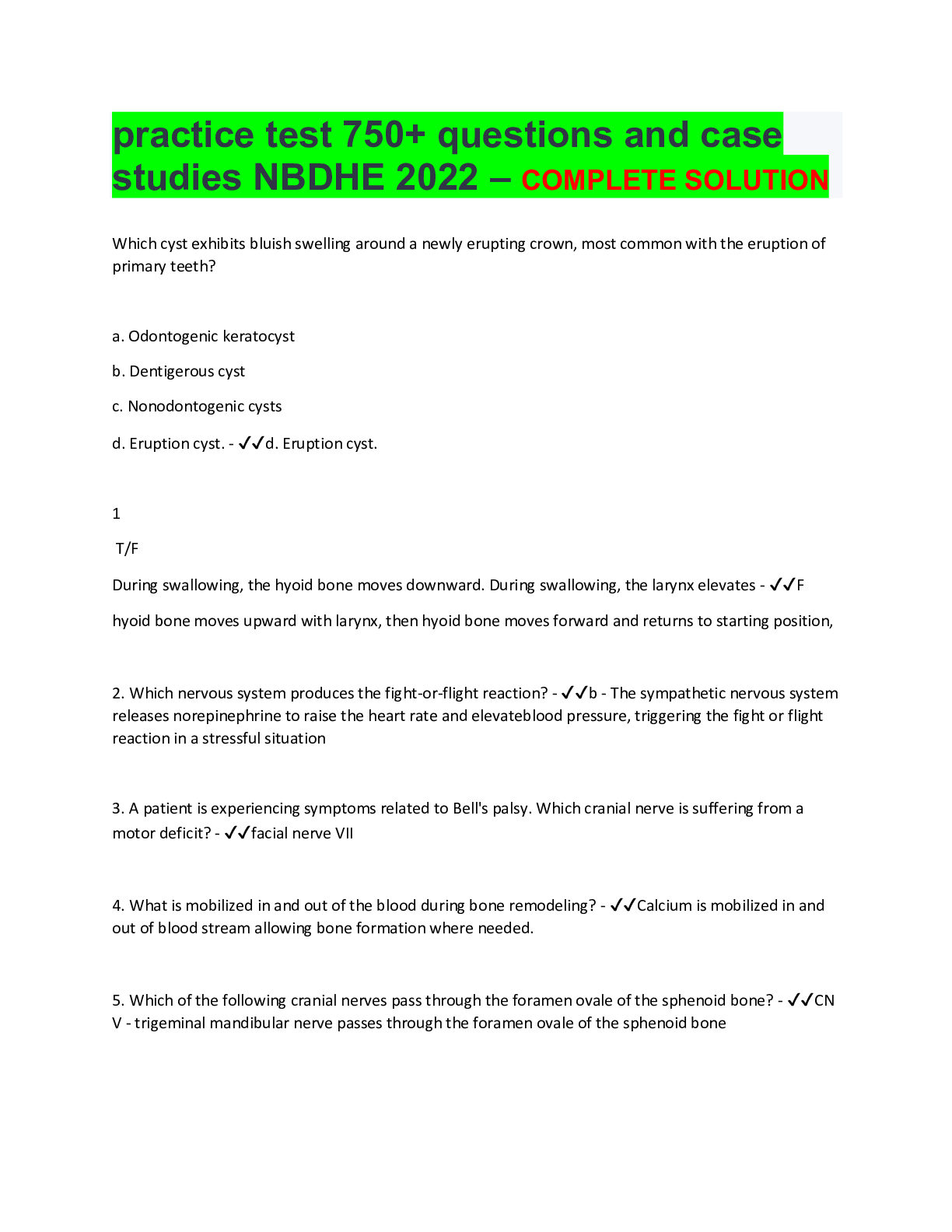
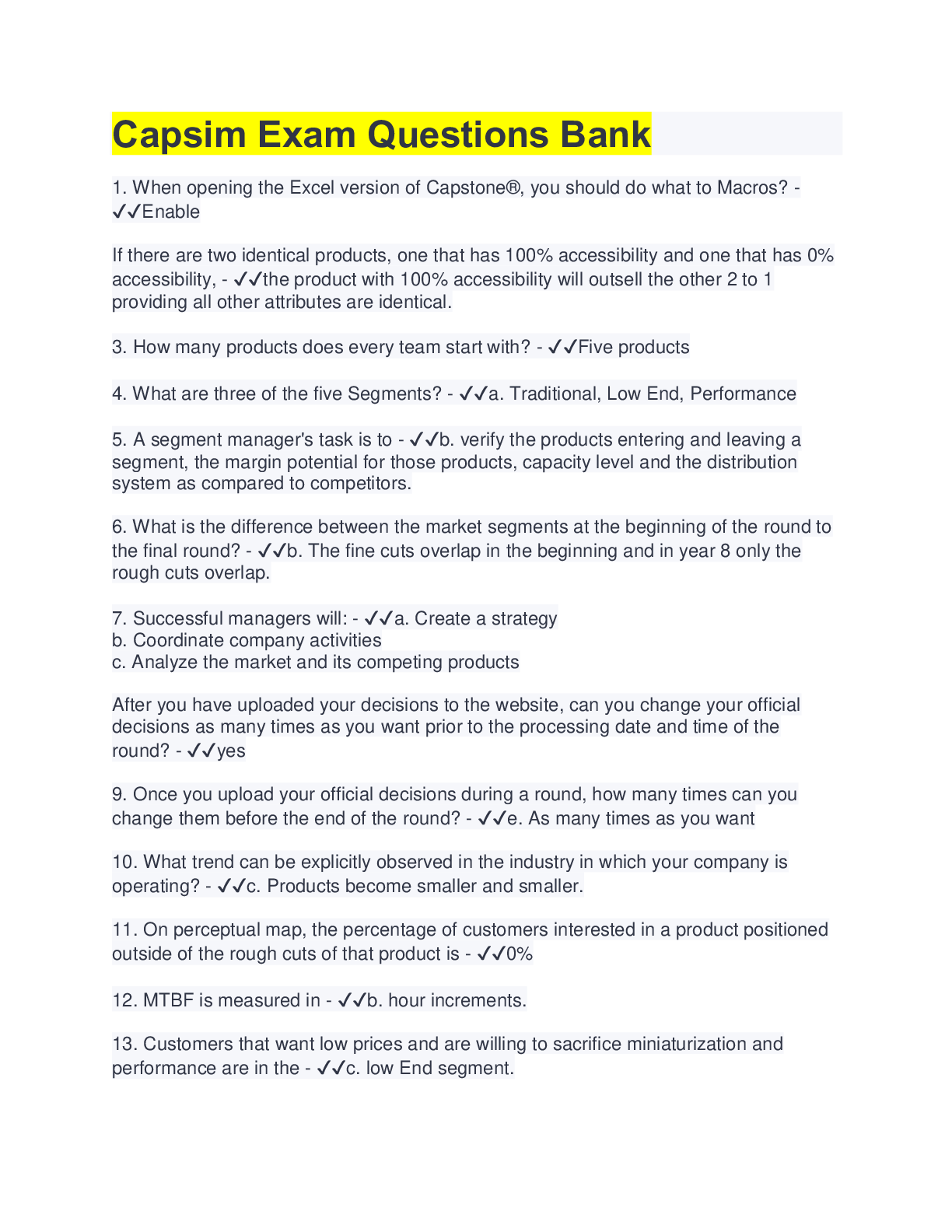





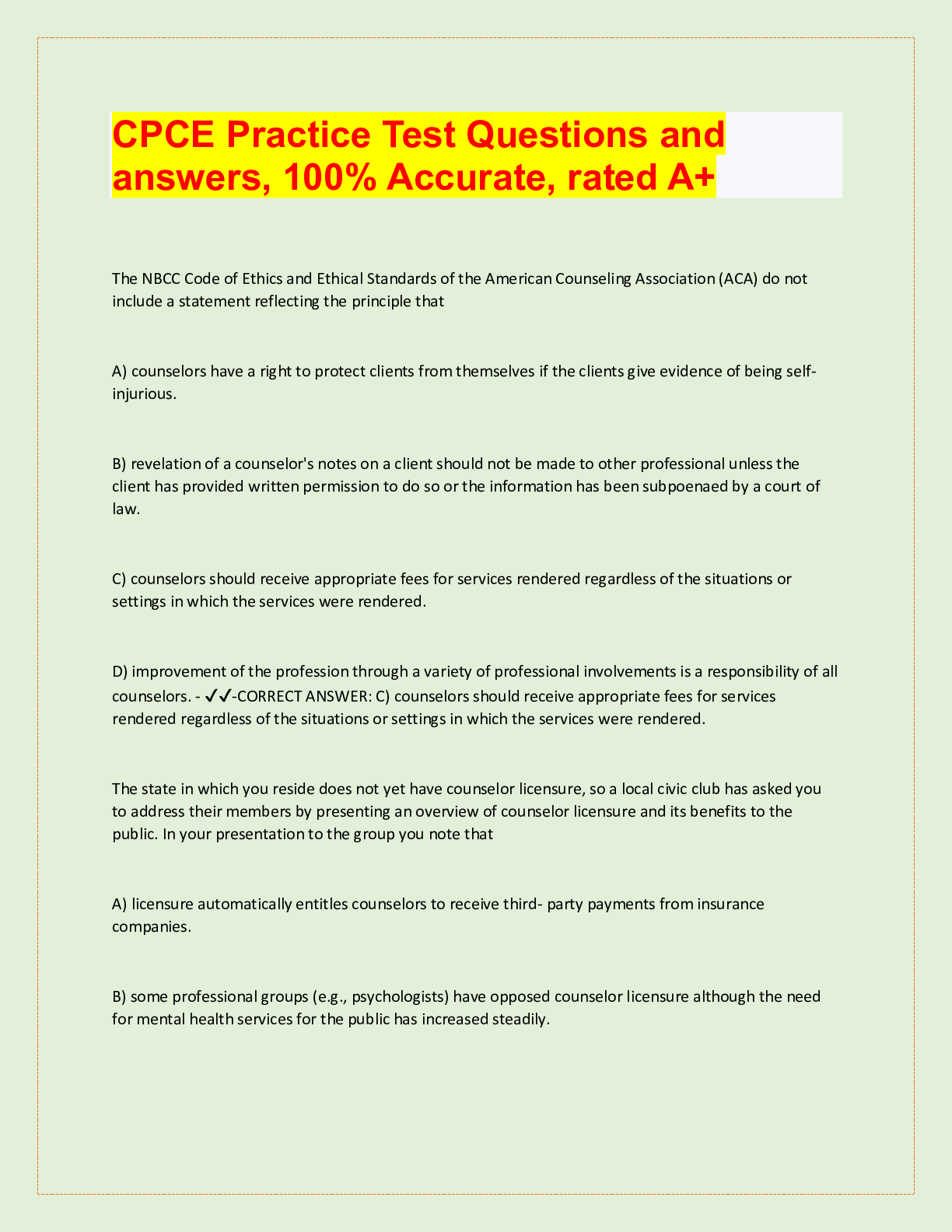

.png)





